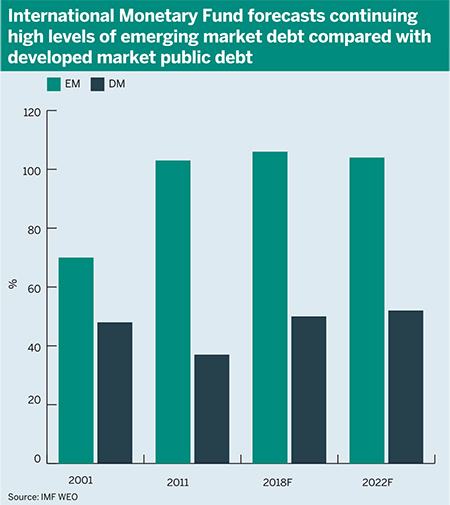Improved understanding of emerging market debt could lead to an increased appetite for the asset class. Some experts argue standalone allocations might become more popular than investing in EMD via multi-asset funds.
Emerging market debt has been cited as one of these opportunities, offering UK pension funds some respite from the effects of low domestic yields.
You have to be a fairly sizeable fund to have a direct mandate to this, but it is worth having that direct mandate
Danny Vassiliades, Punter Southall Investment Consulting
A Greenwich Associates study of investment institutions across the world found that while 91 per cent of participants invest in emerging market equities, only 61 per cent invest in emerging market fixed income.
Emerging market debt is a staple of many pension fund portfolios on the continent, but it “is not yet widely popular” among UK pension schemes, says Mathias Neidert, head of public market research at bfinance.
This situation might change, as EMD “is becoming increasingly important, meaning that… pension funds are considering the asset class”, he adds.
One reason behind this is that EMD can provide those higher yields long-term investors seek, Neidert points out, adding that diversification is another major factor.
Multi-asset route into EMD still dominant
While some UK pension funds might allocate to EMD through segregated mandates, others might feel more comfortable accessing the asset class through a multi-asset approach.
Neidert explains that so far, one of the main ways pension funds have gained exposure to emerging market debt is indirectly through multi-asset credit funds, to solve what he calls the “tactical allocation issue” of “not knowing exactly how much to invest and when to invest”.
But some investors have not been fully satisfied with MAC strategies, and there is now “a shift towards more dedicated standalone exposures to the underlying asset classes that MAC funds are invested in”, says Neidert. This may also include a move to standalone emerging market strategies.
Should schemes opt for a standalone EMD approach?
Danny Vassiliades, managing director at Punter Southall Investment Consulting, says EMD is “worth its own allocation”.
Investing this way is no easy feat for smaller investors. Vassiliades admits that “you have to be a fairly sizeable fund to have a direct mandate to this, but it is worth having that direct mandate” rather than investing through an absolute return fund.
He adds that “it’s certainly worth managing actively, because that active manager should be able to add value in assessing the different currency and credit risks”.

Source: bfinance (figures represent new projects initiated after April 1 2017 and do not include pre-existing client engagements that continued during 2016)
However, Matthew Michael, product director, emerging market debt and commodities at asset manager Schroders, says absolute return funds can be a good entry level option “for those that are getting used to the idea of maybe investing in emerging market debt for the first time”.
The search for income
Alan Pickering, chair of professional trustee company Bestrustees, highlights that in an environment of ‘lower for longer’, trustees “are looking for sources of income… to close that negative cash flow gap”.
He says that for a large scheme, “I might be open to a suggestion that we have a hypothecated allocation to emerging market debt”, while “in all schemes, I would want my bond manager to have access to all sources of income, whether it be state funded or corporate bonds”.
Pickering notes that choosing between investing in EMD via a segregated mandate or as part of a broader bond allocation is something he would test on a scheme-by-scheme basis.
Herd mentality
In principle, Pickering says he is more in favour of having multiple fixed income types within a single manager portfolio “in order that the manager can fine-tune the allocation between the different sources of income, rather than sign up to something which is so narrowly focused”.
Nevertheless, “these things do evolve” and “there are occasions when having narrowly focused allocations makes sense”, he notes.
EMD has benefited from positive performance over the past six to 12 months, contrasting with a period of poor performance following the 2013 taper tantrum.
“In today’s low-yield environment in developed markets, investors will continue to search for yield in EMs,” states a 2017 PGIM white paper.
However, “misconceptions about EM risk — particularly in times of crisis — are slowing this rebalancing”, it adds.

Jan Dehn, head of research at specialist emerging markets fund manager Ashmore, also comments on the way investors tend to remember times of very poor performance for EMD between 2013 and 2015.
For them, “that memory’s a lot more recent than the very strong performance we had, say, 13 years ago… before the financial crisis”.
Dehn says: “Investors are, generally speaking, not particularly good at identifying value. They’re a lot better at identifying what other investors are doing and in general investors… are very, very herd driven.”
Better understanding could boost EMD allocations
While Dehn notes that EMD has enjoyed “strong experience overall” in recent months, he says investor perception and knowledge of emerging markets has not materially changed.
“I don’t think [investors have] become more mature, more insightful. They are still as herd-driven, and therefore the asset class is just as volatile as it’s always been,” he explains.
Punter Southall’s Vassiliades thinks that EMD is “one of those asset classes which is developing and it’s come on people’s radar”.
He says an improved understanding of how the asset class works could lead to an increased number of pension schemes allocating to EMD.
“It’s… a learning curve to get all those pension funds up to speed on the role it has in the portfolio and what it can do,” he explains.
He adds that “once they’re comfortable through that education process, then they should be more willing to use it”.
Click here to read part one, which asks whether positive EMD performance can last














